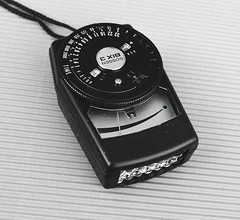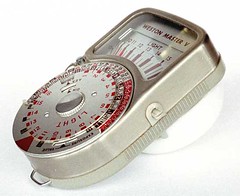Selenium meter

|
| Typical selenium meter window, here on a Gossen Sixon image by AWCam (Image rights) |
A selenium meter is a photoelectric light meter, used to determine exposure settings. In the middle four decades of the 20th century, light meters based on selenium electrical cells were the best available to photographers, and were included in many camera designs. By the mid-1960s, physically smaller and more sensitive CdS cells had replaced selenium in most uses.
A selenium photocell produces more or less electric power when exposed to more or less light. Its output of electrical current is connected an indicator, typically a pivoting electromagnetic coil with a lightweight needle attached. The optical part of such a meter is a lens array in front of the photocell's light sensitive side. This is usually structured like a honeycomb made of convex lenses, which narrows the angle of view to which the meter is sensitive. The remaining part of the light meter is an exposure calculator (often in concentric dials), which takes the light reading and film speed as input parameters, then shows the possible aperture/shutter speed combinations for correct exposure.
Dr. Bruno Lange in Germany developed the first practical selenium photoelectric cell. But the Rhamstine's Electrophot DH of 1931 is believed to be the first selenium light meter manufactured for photographic purposes.[1]
As with other light-meter technologies, selenium meters may be entirely separate from the camera, or be made an integral part of one. Large selenium cells, with their "fly's eye" covering, greatly altered the appearance of many mid-century cameras.
Built-in selenium meters are often coupled to a camera's shutter speed control, with a read-out indicating the appropriate aperture (or, vice versa). More sophisticated camera meters may be coupled to both—or even offer exposure control that is fully automatic. (However this was uncommon during the era when selenium cells prevailed.)
A unique characteristic of selenium light meters as compared to other types of light meters is that they do not require a battery to produce a reading. While this is a significant convenience in the use of these meters, the major disadvantage of this design is that the selenium is very slowly expended as it is used over the years. While these chemical changes take years, given the age of these meters today, many meters that have been left exposed to light are now no longer functional. However, meters that have been kept unexposed to light are often found still in perfect working order. The most effective method of retaining the function of working selenium light meters is to always keep the meter completely covered when not in use; for on-camera meters this is usually possible by simply leaving a light-proof lens cap covering the meter, or leaving the camera in a camera case or bag.

|

|

|

|
| modern Gossen Bix 3 match-needle selenium meter by Uwe Kulick (Image rights) |
Paxette electromatic with meter controlled aperture and light sufficiency signal by Paul Analog (Image rights) |
Weston Master V by Howard Somerville (Image rights) |
Samoca miniature meter to be mounted on camera's accessory shoe by Steve Chatfield (Image rights) |
Notes
- ↑ "J. Thos. Rhamstine and the First Electric Exposure Meter" by Richard W. Holzman in Photogram Newsletter, April-May 2008 published by The Michigan Photographic Historical Society